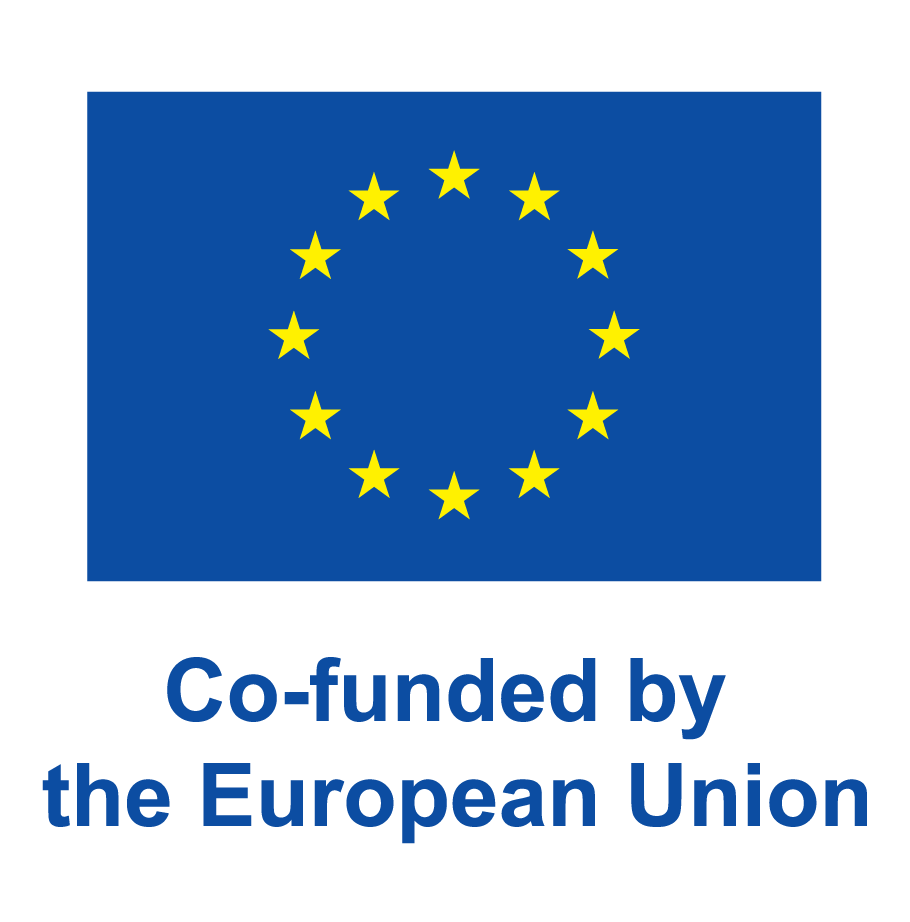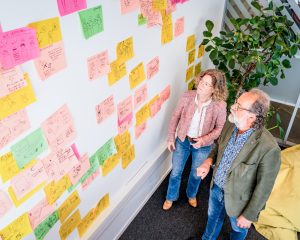New video: DynaPopeX
In the DynaPopeX project, TNO and Zicht op Data focus on reducing poor air quality. By combining data, location, and human movement patterns in Eindhoven, they develop tangible measures to minimize people’s exposure to harmful particulate matter and limit potential health risks. This is crucial for the municipality of Eindhoven to understand the most significant impacts of air quality and improve the health of its residents.
New interns
Eindhoven Engine welcomed a vibrant group of new interns in 2025. Get to know them from left to right. Additionally, four bachelor students from TU/e have started. Over the coming months, they will focus on the climate-adaptive region, working one day a week.
We wish them good luck! We hope the interns gain valuable experience and bring fresh insights to the various programs at Eindhoven Engine. Everyone can make impact on society!
- Cathelijne Brantjes | Human & Technology, 4th year, Avans University of Applied Sciences | Inclusive Society
Research on making blended care more understandable at general practitioners’ offices for people aged 18-40 with reduced digital skills.
- Hilde Schram | Strategic Communication, HBO Master, Fontys University of Applied Science | Communication
Eindhoven Engine focuses on the complex challenges our society faces. Addressing these challenges requires a specific approach. Hilde is researching how this approach can be tackled through strategic communication.
- Levi Deerenberg | Business Innovation, 4th year, Avans University of Applied Sciences | Livable Region
Develop a concept that reduces energy consumption at the residential towers Luna & Aurora on the TU/e-campus by actively influencing the behavior of the residents.
- Ivory Johan | Business Innovation, 4th year, Avans University of Applied Sciences | Livable Region
Develop an innovative concept to increase the engagement and participation of students and staff on the TU/e campus around sustainability, by connecting them with sustainable innovations in an inspiring way.
- David Rozenberg | HBO-ICT (Software) , 4th year, Fontys University of Applied Science | Inclusive Society
Preparing the MetMij chatbot for deployment and real-world use. MetMij easily directs people with low basic skills to appropriate support agencies.
- Santiago Triginer | Industrial Engineering, 3rd year, Eindhoven University of Technology | Livable Region
Identifying challenges and solutions for solar panel reuse, and exploring how AI can enhance recycling processes.
- Mare Gijsbers | Business Innovation, 4th year, Avans University of Applied science | Inclusive Society
Develop a methodology to effectively and accessibly introduce the ‘Met Mij’ app to users with low literacy, enabling them to quickly and easily receive support to participate fully in society.
- Rosalie Hendriks | Business Innovation, 4th year, Avans University of Applied Sciences | Inclusive Society
Develop a new concept for people with low basic skills between the ages of 18 and 40 in the Eindhoven region, in such a way that these people can independently ensure the security of their financial situation.
Building a Healthier Future
My Journey at Eindhoven Engine
Hello, my name is Golnoosh Sabahifard, and I am currently pursuing my EngD traineeship at Eindhoven Engine. My focus is on the Livable Region program, where I am committed to enhancing the public well-being of residents.
At Eindhoven Engine, our mission is to create a sustainable and livable Brainport region where everyone can live healthily and safely. Our goals include reducing health disparities in neighbourhoods by 20% and adding three healthy living years for every person.
Understanding public well-being
Public well-being is influenced by eight factors: loneliness, stress, fewer years of good perceived health, lack of green spaces, noise pollution, population density, and distance to basic facilities. My research focuses on evaluating the effectiveness of current assessment tools and developing a dynamic model that visually illustrates how these factors interact to affect urban health.
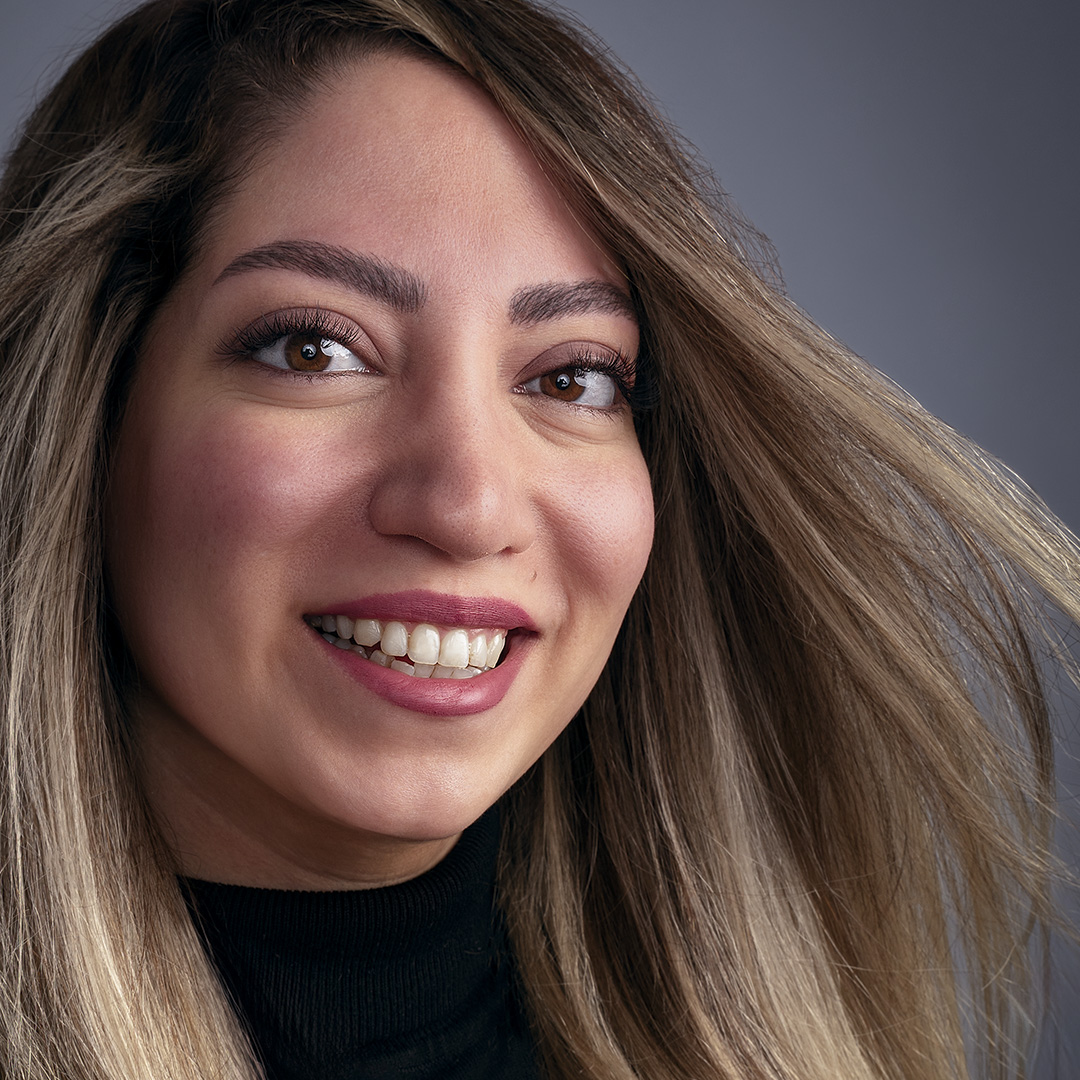
The importance of interactive and dynamic analysis
The built environment significantly impacts public well-being, influencing both mental and physical health. Traditional urban assessment tools often lack interactive and dynamic analysis, making it difficult to estimate the long-term impacts of various elements.
My traineeship aims to change this. I am using Vensim, a visual modeling tool, to provide a data-driven, visual method that helps stakeholders understand how small changes in urban planning can lead to significant health benefits. This approach is crucial for evidence-based urban planning, enabling policymakers to make informed decisions to create healthier, more sustainable cities.
Ultimately, this work will lay the foundation for future research on building healthy and sustainable urban environments.
Media: Technologie in de volwasseneneducatie (2)
Inclusive technology in educational pathways for adults
In an interview (in Dutch) with Lotte Geertsen (Program manager Inclusive Society) and Walter Baets (Wicked Problems officer), about technology in adult education, they explain that a different way of thinking is needed to innovate. Met Mij from Eindhoven Engine, is designed for people with lack of basic skills, is a perfect example.
𝑇ℎ𝑖𝑠 𝑖𝑠 𝑝𝑎𝑟𝑡 𝑡𝑤𝑜 𝑜𝑓 𝑎 𝑡𝑤𝑜-𝑝𝑎𝑟𝑡 𝑖𝑛𝑡𝑒𝑟𝑣𝑖𝑒𝑤. 𝑅𝑒𝑎𝑑 𝑝𝑎𝑟𝑡 𝑜𝑛𝑒 ℎ𝑒𝑟𝑒.
[Article is in Dutch]
Eindhoven Engine News – December 2024
In this edition of Eindhoven Engine News: Innovation accelerator Eindhoven Engine enters new phase, Transforming basic skills support with AI and more!
What else is happening at Eindhoven Engine?
Transforming basic skills support with ai
For over two years, the Inclusive Society focus area at Eindhoven Engine has been tackling the complex issue of lack of basic skills. Driven by the belief that everyone deserves to participate fully in society, we have deeply explored this challenge to find ways to bridge the gap between individuals with low literacy skills and the broader community.

Jéssica Goss, EngD Doctorate in Designing Human-Systems Interaction, joined Eindhoven Engine two years ago to research effective methods to support this group. Her work has been instrumental in shaping our approach.
Met Mij
Met Mij aims to connect individuals with basic literacy needs to the social services available in the Eindhoven region. Despite the presence of over 200 organizations, 8 out of 10 people initially find themselves in the wrong place, leading to feelings of shame and insecurity. By addressing this mismatch and the stigma faced by individuals aged 16 to 40—the hardest group to reach—we are creating an ecosystem where help is both accessible and effective. Our goal is to understand each person’s unique needs, connect them with the right local support, and build their confidence and independence by ensuring they receive the correct assistance on the first try.
A human-centric design approach & AI
We use a human-centric design approach combined with advanced AI technology to provide personalized and stigma-free assistance. Through “Mijke,” our WhatsApp matchbot, users can access services by simply typing or speaking a message. This method ensures ease of use and meets the target group where they are—online. By collaborating with local organizations, we continuously refine Mijke based on real-world feedback, creating a seamless connection between technology and human needs.
Working together with CSU
Most recently, Met Mij participated in CSU’s Innovation Award 2024 and advanced to the semi-finals. Although it did not win, CSU, a professional cleaning company in The Netherlands, recognized the potential of the solution and initiated further collaboration with Eindhoven Engine to test and refine Mijke with their employees. The ongoing tests made by the team have received positive feedback, offering essential insights to improve the tool and ensure it creates a meaningful impact for those it aims to support.
Building a more inclusive Eindhoven
Join us in making Met Mij a reality!
Whether you want to test the tool, contribute your technological expertise, or support us with funding, your involvement is invaluable. Together, we can create a future where everyone has access to the support they need, exactly when they need it. Let’s build a more inclusive Eindhoven and expand this vision to other cities and countries.
Inclusive society
In the Netherlands, 2.5 million people struggle with reading, writing, arithmetic and/or digital skills. These people are confronted with immense challenges on a daily basis, which seriously hinders their participation in society. Eindhoven Engine emphasizes the urgency of this problem and the need for action.
Media: Technologie in de volwasseneneducatie (1)
Inclusive technology in educational pathways for adults
At Eindhoven Engine, we are dedicated to leveraging AI technology to support individuals who struggle with reading and writing, helping them better integrate into society and mitigate the challenges they face.
Our Inclusive Society team has developed the Mijke Tool, an innovative solution integrated into WhatsApp. This tool provides easy access to the right services and assistance for those in need. In a recent article, Ina den Hollander and Ben Vaske from oefenen.nl showcased various applications, including Mijke, demonstrating how AI can foster greater inclusivity. Together, we are making strides towards a more inclusive society where everyone has the opportunity to thrive.
𝑇ℎ𝑖𝑠 𝑖𝑠 𝑝𝑎𝑟𝑡 𝑡𝑤𝑜 𝑜𝑓 𝑎 𝑡𝑤𝑜-𝑝𝑎𝑟𝑡 𝑖𝑛𝑡𝑒𝑟𝑣𝑖𝑒𝑤. 𝑅𝑒𝑎𝑑 𝑝𝑎𝑟𝑡 two ℎ𝑒𝑟𝑒.
[article is in Dutch]
Media: Innovation accelerator Eindhoven Engine enters new phase
Technology with a clear social purpose an starting with the problem.
As a society, we face numerous challenges. At Eindhoven Engine, a collaborative program between companies, knowledge institutions, social organizations and citizens in the Brainport region, work has been going on for years on innovations to address these problems. Now the program is breaking new ground.
Source: Eindhoven University of Technology
Media: Technologie met een duidelijk maatschappelijk doel:
[Dutch]
Innovatieversneller Eindhoven Engine gaat nieuwe fase in
Als maatschappij staan we voor talloze uitdagingen. Bij Eindhoven Engine, een samenwerkingsprogramma tussen bedrijven, kennisinstellingen, maatschappelijke organisaties en burgers in de Brainportregio, wordt er al jaren gewerkt aan innovaties om deze problemen het hoofd te bieden. Nu slaat het programma een nieuwe weg in.
Source: Innovation Origins
Science, industry and government seek solution to grid congestion via large-scale living lab on TU/e campus
In the search for solutions to the current grid congestion problem, science, industry, and government are joining forces, killing two birds with one stone.
With the OPZuid project GENIUS, TU/e wants to tackle grid congestion together with companies, municipalities, and the province and, at the same time, set up a sustainable testing ground for relevant future innovations. The starting signal is to commission a battery pack in the size of no less than a sea container for the storage of electrical energy on Monday, 18 November.
The GENIUS battery is essential to a smart control platform that aligns different industrial users, energy sources, and storage systems to prevent energy peaks. The lithium iron phosphate battery contains no cobalt or nickel and acts as energy storage and a control tool. It can coordinate and optimize complex data, allowing it to advise on and anticipate the energy needs of the more than forty faculty and business buildings on the TU/e campus, on which approximately fifteen thousand people depend daily. The energy hub is connected to the public energy grid, allowing energy to be fed back into the grid or shared with users in the local area.
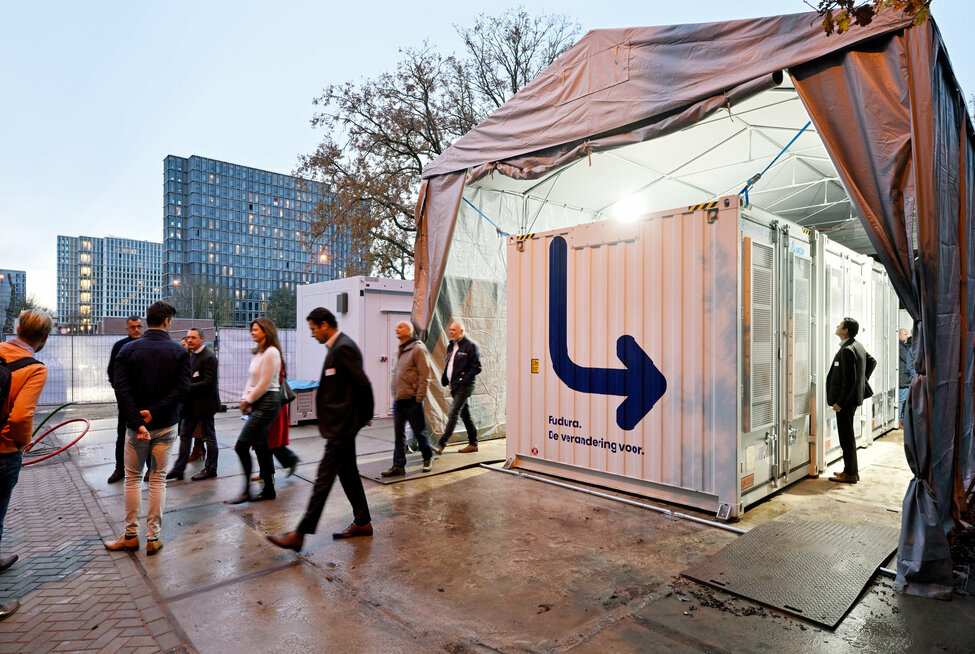
Spreading the rush hour
This battery pack ensures that TU/e no longer causes any exceedances on the contracted capacity and balances the energy consumption better. Simply put, the congestion problem on the energy grid is solved by spreading the morning and evening rush hours. This offers room for further sustainability and expansion of the campus within the current contracted capacity. Think, for example, of heat pumps in combination with Heat and Cold Storage and the arrival of a new clean room.
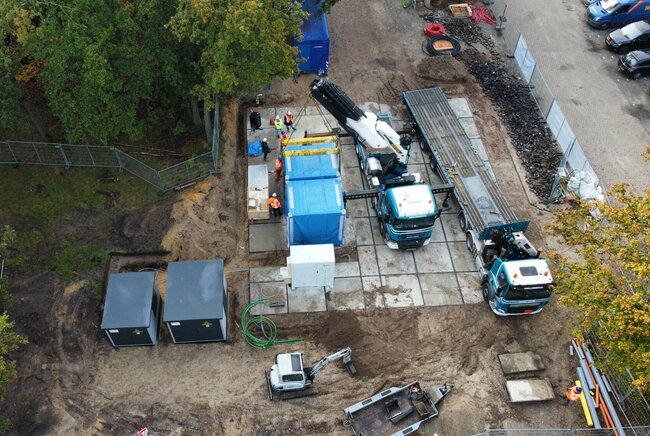
The package easily pays for itself thanks to smart charging and discharging and peak shaving (energy storage when there is little demand and deployment during peak periods). For TU/e, it provides an estimated 20% extra space on its energy grid and capacity because less has to be purchased at unfavorable times (during ‘rush hour’), which lowers the total costs.
This is also beneficial for the grid load in general because TU/e ‘gets out of traffic jams’ at such peak times. More gains can be made in (among other things) the areas of (minimal) CO2 emissions, balancing grid congestion at regional and national levels (TU/e can consume more energy without increasing its connection, leaving capacity for the local area), energy security, peak reduction or the prevention of exceedances on the energy connection.
Blueprint for Dutch industry and grid operators
The system approach not only alleviates the energy needs of the (growing) TU/e campus and distributes them more efficiently but should also ultimately provide a blueprint for Dutch industry and grid operators to tackle grid congestion efficiently. Initially, for the approximately 3500 industrial estates in the Netherlands, mainly in the south of the Netherlands, where grid congestion is slowing down the energy transition and hindering economic growth. That blueprint could then be on the market in four years. This makes OPZuid GENIUS (Grid Efficiency Network Integration for Universal Sustainability) a strategic project with interest from society as a whole, in which open innovation predominates.
In fact, the project functions as a micro-society on campus, providing valuable knowledge about user behavior and how it is influenced and changed by insight into energy use patterns in the long term. This behavioral knowledge is crucial to developing strategies that drive effective behavioral change and promote energy efficiency.
Consortium around OPZuid GENIUS
TU/e President of the Executive Board Robert-Jan Smits: “I am tremendously proud of this project because it brings together a lot of what we stand for as TU/e. With this we are working on sustainability, on solving the grid congestion that all of the entrepreneurial Netherlands is facing, and we are doing this – as a true 4th generation university – in collaboration with a wide range of partners in the region, focused on social impact.”
Mark Cox, Senior Program Manager Energy TU/e: “The GENIUS battery, in combination with intelligent software, can store energy when demand is low so that we can use it during peak times. Thanks to AI, other users, both on campus and in the local area, will not notice this. On the contrary, everyone can benefit from it. When the new Energy Act comes into effect next year, adjacent power grids can be connected. The cleverness of our system approach should then ensure that everyone is always supplied with energy without crossing borders.”
When the new Energy Act comes into effect next year, adjacent power grids can be connected. The cleverness of our system approach should then ensure that everyone is always supplied with energy without crossing borders.
Tom Selten, founder of Simpl.Energy: “With our software, we control the battery, charging stations, and solar panels so that TU/e always remains within the connection. In addition, we optimize the purchase of electricity, thereby minimizing energy costs. And as icing on the cake, with our platform, TU/e has one place where they can see whether all systems are working properly and how much is being earned and saved.”
Daan Pelders, business developer Fudura: “At Fudura, we are proud to be able to participate in this innovative process. We are supplying one of the largest batteries in the Brainport area and integrating it into TU/e’s private grid. We have been TU/e’s partner in energy infrastructure and metering services for many years, and we are grateful for the trust we have received to carry out this project.”
The consortium around OPZuid GENIUS consists of the following parties: TU/e department Real Estate, EIRES, EAISI, Fudura, RIFT, Simpl.Energy, Voltgoed, VBOptimum, ZEnMo, Cube Charging, Enerzien, Eindhoven Engine and Woonbedrijf. An active and connected support group includes the province and municipality, as well as the regional grid operator Enexis. This project was co-financed by the European Union through the award of an OPZuid grant.


